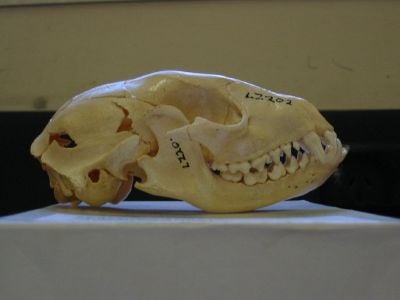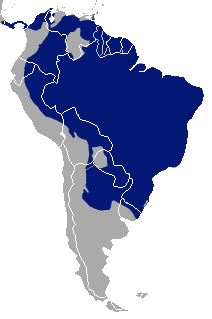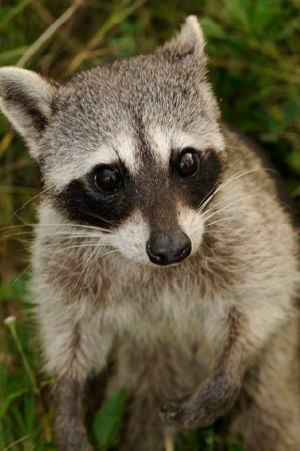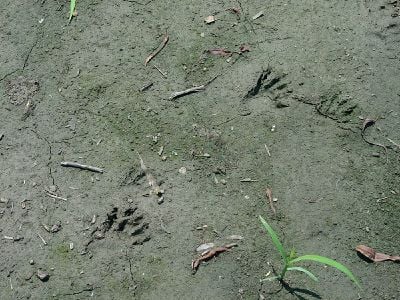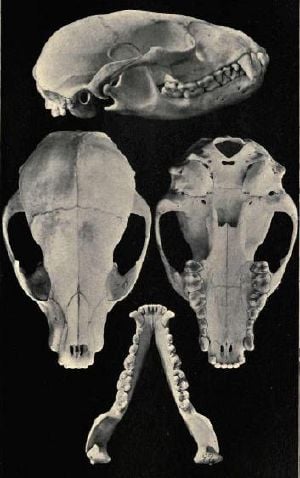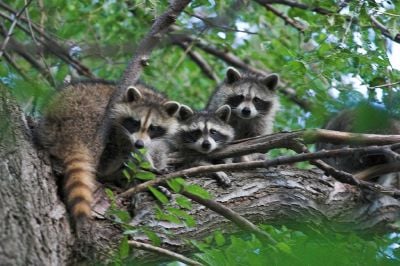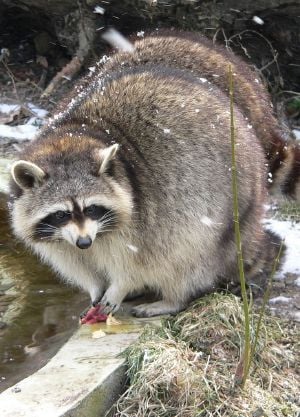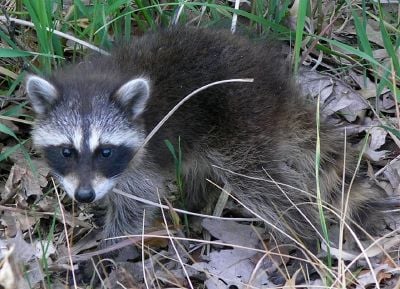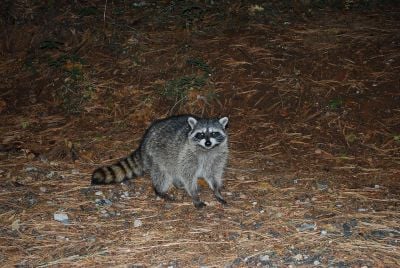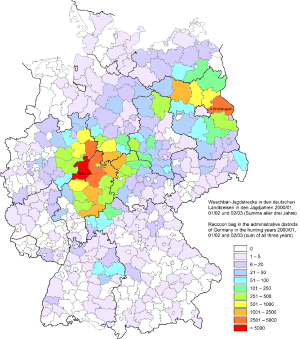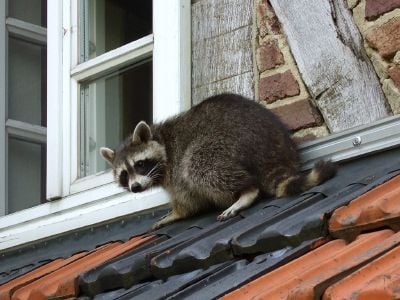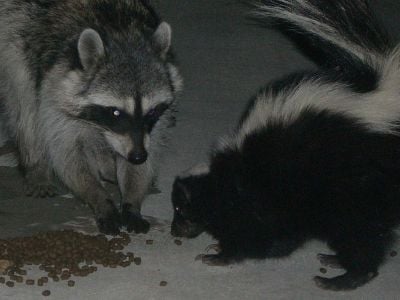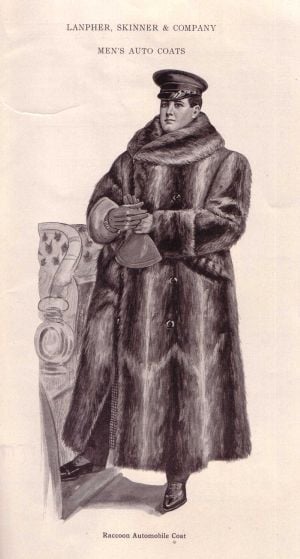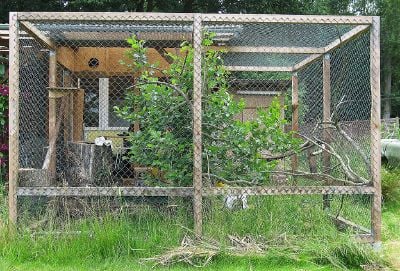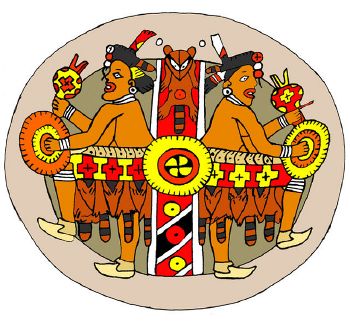| Procyon | ||||||||||||
|---|---|---|---|---|---|---|---|---|---|---|---|---|
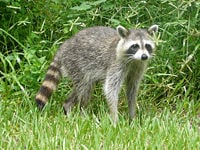 Common raccoon (P. lotor)
| ||||||||||||
| Scientific classification | ||||||||||||
| ||||||||||||
| Procyon lotor Linnaeus, 1758 | ||||||||||||
Raccoon (sometimes racoon) is the common name for any of the New World mammals comprising the genus Procyon of the Carnivora family Procyonidae, and particularly is associated with the common raccoon, P. lotor. Members of all three extant species of the Procyon genus are characterized by a black mask on the face, robust body, bushy tail with rings, plantigrade hindfeet, non-retractile claws, and an omnivorous, nocturnal nature. The term raccoon also is used sometimes as a collective term for all members of the family Procyonidae (the "raccoon family"), which includes the coati, kinkajous, and others, although procyonids is a more distinct term.
The "common raccoon," P. lotor, also known simply as "the raccoon," is the most widely distributed species, with a natural range from southern Canada to Panama. It has also been introduced to continental Europe. The tropical "crab-eating raccoon," P. cancrivorus, ranges from Costa Rica through most areas of South America east of the Andes down to northern Argentina and Uruguay. A much rarer species, the "Cozumel raccoon," P. pygmaeus, is native to Cozumel Island off the Atlantic coast of Yucatan.
Raccoons have a reputation as being clever and mischievous and their dexterous, slender, human-like hands enable them to open many closed containers (such as garbage cans and doors). The intelligence and adaptability of the common raccoon has equipped it to survive in a wide range of environments and it is one one of the few medium-to-large-sized animals that have enlarged their range since human encroachment began (another is the coyote). They have readily adapted to urban environments, scavenging garbage bins, and other food sources.
Raccoons provide important ecological values and also add to the human fascination with nature. Important in terrestrial and, to some extent, aquatic food chains, raccoons consume a diversity of insects and other invertebrates (such as crayfish, crabs, and lobsters), some vertebrates (such as frogs, rodents, fish, and bird and turtle eggs), and plant matter (fruits, nuts) as well, while being consumed by coyotes, large birds of prey (hawks, owls), and the young by snakes. In such a role, raccoons help in maintaining the balance of prey populations and provide food for other animals. For humans, they have been used for pelts, for food, and sometimes, while not domesticated, they are even raised as pets. However, they also can be considered vermin or a nuisance. They can damage crops, chicken yards, orchards, and vineyards, and can transmit diseases and parasites to humans and domestic animals.
Genus Procyon
Procyon, the taxonomic unit in which raccoons are placed, is a genus in the mammalian family Procyonidae and order Carnivora. As members of the family Procyonidae and the subfamily Procyoninae, raccoons are placed with coatis (comprising the genus Nasua), mountain coatis (genus Nasuella), and the ringtails and cacomistles (genus Bassariscus).
Extant raccoons have a stout body, short legs, long digits with non-retractile claws, a black mask on the face that goes across the eyes, a pointed muzzle, and they have a bushy tail with black rings. Raccoon hindfeet have been described as plantigrade (with soles touching the ground), similar to those of humans and bears, and their entire sole is on the ground when standing, although they might also be described as semi-plantigrade since they move at times with their heels off the ground. Raccoons are unusual in that their thumbs (though not opposable) and human-like hands give them a lot of dexterity, allowing them to open many closed containers.
Although there is some variation depending on the species in question, raccoons range from 20–40 inches (51–100 cm) in length (including the tail) and weigh between 10 and 35 pounds (4.5 and 16 kg). The raccoon's tail ranges from 8 to 16 inches (20 to 41 cm) in length Male raccoons are generally larger than females. A baby raccoon is called a kit.
Species
There are three extant species of raccoon.
Procyon lotor is the most familiar species and is known as the "common racoon," the North American raccoon, the northern raccoon, or even simply as "the raccoon," since the two other raccoon species in the genus are native only to the tropics and are considerably lesser-known. The common raccoon has a natural range from southern Canada to Panama, and has been introduced to continental Europe. It has been know to live in the city in addition to the wild.
P. cancrivorus, the tropical "crab-eating raccoon," ranges from Costa Rica through most areas of South America east of the Andes down to northern Argentina and Uruguay.
P. pygmaeus, the "Cozumel Island raccoon," is a much rarer species than the other two. It is native to Cozumel Island off the Atlantic coast of Yucatan.
The third edition of D. E. Wilson and D. M. Reeder's Mammal Species of the World: A Taxonomic and Geographic Reference (2005) list the above three species as the only distinct extant species of the genus Procyon.[1] Some raccoons once considered separate species are now thought to be the same as or subspecies of the common raccoon, including the Barbados raccoon (P. gloveralleni), Nassau raccoon (P. maynardi), Guadeloupe raccoon (P. minor), and Tres Marias raccoon (P. insularis).[2] Procyon brachyurus Wiegmann, 1837 was described from captive specimens; its identity is undeterminable as the remains of the two animals assigned to this taxon cannot be located anymore and may have been lost.
Taxonomy and evolution
Genetic studies have shown that the closest relatives of the raccoon are the ring-tailed cats, coatis, and cacomistles.[3]
In the first decades after its discovery by the members of the expedition of Christopher Columbus—the first person to leave a written record about the raccoon—taxonomists thought the raccoon was related to such taxonomic groups as dogs, cats, badgers, and particularly bears.[4] Carl Linnaeus, the father of modern taxonomy, placed the raccoon in the genus Ursus, first as Ursus cauda elongata ("long-tailed bear") in the second edition of his Systema Naturae, then as Ursus lotor ("washer bear") in the tenth edition.[4][5] In 1780, Gottlieb Conrad Christian Storr placed the raccoon in its own genus Procyon, which can be translated either to "before the dog" or "dog-like".[4][5] It is also possible that Storr had its nocturnal lifestyle in mind and chose the star Procyon as eponym for the species.[6][4]
Based on fossil evidence from France and Germany, the first known members of the family Procyonidae lived in Europe in the late Oligocene about 25 million years ago.[5] Similar tooth and skull structures suggest procyonids and weasels share a common ancestor, but molecular analysis indicates a closer relationship between raccoons and bears.[5] After the then-existing species crossed the Bering Strait at least six million years later, the center of its distribution was probably in Central America.[5] Coatis (Nasua and Nasuella) and raccoons (Procyon) have been considered to possibly share common descent from a species in the genus Paranasua present between 5.2 and 6.0 million years ago.[5] This assumption, based on morphological comparisons, conflicts with a 2006 genetic analysis that indicates raccoons are more closely related to ringtails.[3]
Unlike other procyonids, such as the crab-eating raccoon (Procyon cancrivorus), the ancestors of the common raccoon left tropical and subtropical areas and migrated farther north about 4 million years ago, in a migration that has been confirmed by the discovery in the Great Plains of fossils dating back to the middle of the Pliocene.[5][6]
Etymology
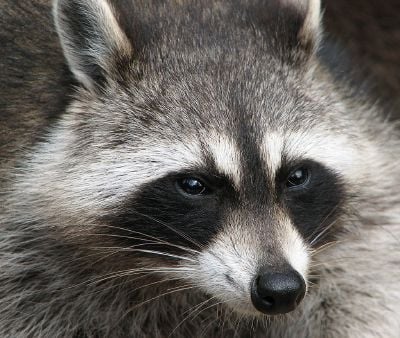
The word "raccoon" was adopted into English from a native Powhatan term, as used in the Virginia Colony. (Powhatan is a member of the Native American [Algonquian]] language family.) It was recorded on Captain John Smith's list of Powhatan words as aroughcun, and on that of William Strachey as arathkone. It has also been identified as a Proto-Algonquian root aroughcoune ("ahrah-koon-em"), meaning "[the] one who rubs, scrubs and scratches with its hands."[4][5] Similarly, Spanish colonists adopted the Spanish word mapache from the Nahuatl mapachitli of the Aztecs, meaning "[the] one who takes everything in its hands".[4]
In many languages, the raccoon is named for its characteristic dousing behavior in conjunction with that language's term for "bear." All of the following mean "washing bear": Waschbär in German, mosómedve in Hungarian, vaskebjørn in Danish and Norwegian, tvättbjörn in Swedish, wasbeer in Dutch, pesukarhu in Finnish, araiguma (アライグマ) in Japanese, orsetto lavatore in Italian, huànxióng (浣熊) in Chinese, and mieshta mechka (миеща мечка) in Bulgarian.
In French and Portuguese (in Portugal), the washing behavior is combined with these languages' term for rat, yielding, respectively, raton laveur and ratão-lavadeiro. In some cases, the "washing" descriptor is applied only to the common raccoon species, such as with the French raton laveur. In contrast, the crab-eating raccoon is "little crab-catching rat" (raton crabier) and "crab-eating pre-dog" (Procyon cancrivorous) in French and Latin, respectively.
A notable exception to the association with dousing behabior is Russian, where raccoon is named yenot (енот) due to similarity between raccoon and genet furs. However, the full name of the common raccoon in Russian is also “water-related”: it is called yenot-poloskun (енот-полоскун), which means "rinsing raccoon."
The colloquial abbreviation coon sometimes used for the common raccoon is used in words like coonskin for fur clothing and in phrases like old coon as a self-designation of trappers.[4][5] However, the clipped form is also in use as an ethnic slur.
Crab-eating raccoon, Procyon cancrivorus
| Crab-eating raccoon |
|---|
 in Manuel Antonio National Park, Costa Rica
|
| Scientific classification |
|
|
| Procyon cancrivorus (Cuvier, 1798) |
The crab-eating raccoon (Procyon cancrivorus) is native to marshy and jungle areas of Central and South America (including Trinidad and Tobago). It is found from Costa Rica south through most areas of South America east of the Andes down to eastern and western Paraguay, northern Argentina, and Uruguay.[8][9] In Central America, the crab-eating raccoon's range overlaps with that of the common raccoon, P. lotor.
The crab-eating raccoon resembles its northern cousin, the common raccoon, in having a bushy ringed tail and "bandit mask" of fur around its eyes. The mask of P. cancrivorus fades behind the eyes, while the mask of P. lotor extends nearly to the ears.[9] The crab-eating raccoon appears smaller and more streamlined than the common raccoon due to its lack of underfur (an adaptation to the warmer environments in which it is found), although it is of roughly similar dimensions. Its pelage is less grizzled in appearance dorsally than the pelage of the common raccoon. Body lengths commonly range from 54 to 65 centimeters (21 to 26 in) with the tail some 25 to 38 cm (10 to 15 in) of the total length; weights commonly range from 3 to 7 kg (6.5 to 15.5 lb).[9] Males are usually larger than the females.
Although P. cancrivorus is known as the crab-eating raccoon, this does not mean that only this raccoon species will eat crabs, or even that its diet is mostly crabs; the common raccoon and particularly the Cozumel raccoon will also seek and eat crabs where they are available, and P. cancrivorus has a varied omnivorous diet with fruit as the main part of its diet.[9] In addition to fruit and crabs, the crab-eating raccoon eats lobster, and other crustaceans, small amphibians, turtle eggs, and vegetables, and nuts.
While the crab-eating raccoon is found in a diversity of habitats, including forest, it particularly is common around areas with bodies of waters, such as swamps, lakes, and lagoons; where its range overlaps with P. lotor, the crab-eating raccoon mainly is found in lands surrounding rivers while the common raccoon is found in swamps and beaches.[9]
The crab-eating raccoon is a solitary nocturnal. It breeds once per year, with young born between July and September. Typically, there are three to four pups to a litter. Young are born with their eyes closed and without teeth; eyes open after about three weeks and they become independent at about 8 months.[9]
Cozumel raccoon, Procyon pygmaeus
| Cozumel raccoon[1] |
|---|
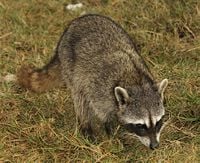 Cozumel Island raccoon
|
| Scientific classification |
|
|
| Procyon pygmaeus (Merriam, 1901) |
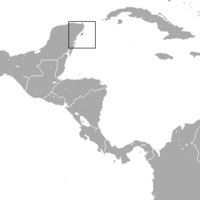 Cozumel Raccoon range
|
The Cozumel raccoon (Procyon pygmaeus), also called the pygmy raccoon,[11] is a critically endangered species of raccoon endemic on Cozumel Island off the coast of the Yucatan Peninsula, Mexico.[10][5] This species is also known by such common names as the dwarf raccoon, Cozumel Island raccoon, Cozumel raccoon, and Cozumel raccoon bear.[10]
Considered critically endangered according to the IUCN Red List, there are only about 250 to 300 individuals left on the planet.[10] Their small geographic range makes the survival of this species precarious: They exist in nature only a small island, Cozumel Island, off the east coast of the Yucatan Peninsula in Mexico.[12]
Merriam first described the Cozumel raccoon as morphologically distinctive from its mainland relative, the common raccoon subspecies Procyon lotor hernandezii, in 1901. Merriam noted that the Cozumel raccoon is markedly smaller, both externally and cranially, from the common raccoon and is easy to distinguish from the common raccoon because of its "broad black throat band and golden yellow tail, short posteriorly expanded and rounded nasals and peculiarities of the teeth."[13] Since then, other scientists have generally agreed with Merriam's assessment.[11][2] Cuaron et al. report that research conducted by many different scholars concludes that the Cozumel raccoon and the common raccoon are separate species.[14] Other morphological differences reported by Cuaron et al., besides the smaller body size and cranium, include the broad black throat band, golden yellow tail, and reduced teeth, and note “that these and other characteristics point to a long period of isolation.” [14] Goldman and Jackson also note that its reduced teeth point to a long period of isolation.[15]
The Cozumel raccoon weighs only 3 to 4 kilograms on average. Its small body size and cranium size have lead to the name "pygmy raccoon." An archaeological study showed that Maya from Cozumel used raccoons of reduced stature, which suggests that the size reduction of this raccoon is not a recent phenomenon.[16]
On the island, the Cozumel raccoons exist only in very specific habitats under certain conditions. Their preferred habitats are limited to the mangrove forests and wetlands in the northwest tip of the island.[12] In these mangrove stands, they tend to prefer the sandy soils that are present there. [14] They have also been captured during population studies in small portions of the semi-evergreen forests surrounding these preferred habitats.[17] Nowhere else on the island do they exist, causing an already limited range to be further reduced by a specific habitat.
The habitat specificity of pygmy raccoons is in large part due to the type of foods they consume. Their overall diet consists of crabs, fruit, frogs, lizards, and insects.[12] They are a generalist omnivore, but crabs make up most of their diet. In fact, over 50 percent of their diet is made of crabs. Their diet is somewhat seasonal.[12] During the wet season, fruit and vegetation are more abundant and become a large portion of the raccoons’ diet. Then in the dry season, they begin to consume more of the crabs, insects, lizards, and so forth. Being that crabs comprise the majority of the food they eat, this could be the reason their distribution is so limited. They stay near the water where crabs are abundant.
The raccoons live in densities of about 17-27 individuals per square kilometer. McFadden et al. have presented data suggesting that the raccoons’ total home range size is about 0.65 ± 0.26 km2 [17] There is not much evidence suggesting that individuals defend territories to a great extent.
Island carnivores at the top of the food chain often become extinct soon after the arrival of humans.[18] The main danger to the pygmy raccoon is development of Cozumel due to the tourism industry.[19] Because the raccoons are only located in a small coastal area at the northwest corner of the island—an area coveted for development—the effects of habitat loss are especially severe. There are no laws protecting the raccoons and also no land set aside for them.[19]
Newer threats to their survival that have been researched in recent years are diseases and parasites.[20] Cozumel has a population of feral cats and domestic cats and dogs that can transmit diseases to the raccoons.[20] On average, there are about 2 different species present in each host. That is not overall abundance, but simply the absolute number of species found. Some captured raccoons had developed antibodies to certain diseases. Cats are only newly introduced on the island due to humans bringing them as pets.[20]
Common raccoon, Procyon lotor
| Raccoon |
|---|
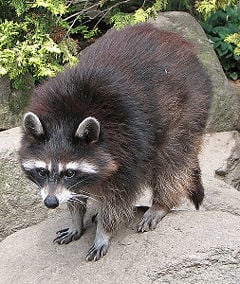 |
| Scientific classification |
|
|
| Procyon lotor (Linnaeus, 1758) |
 Native range in red, introduced range in blue
|
|
Ursus lotor Linnaeus, 1758 |
The common raccoon (Procyon lotor) is the largest extant species of the procyonid family and also the most widely distributed. P. lotor also goes by such common names as "North American raccoon,"[5] "northern raccoon,"[22] the "raccoon,"[5] and colloquially as "coon."[5]
Four subspecies of the common raccoon endemic to small Central American and Caribbean islands were often regarded as distinct species after their discovery. These are the Bahaman raccoon and Guadeloupe raccoon, which are very similar to each other; the Tres Marias raccoon, which is larger than average and has an angular skull; and the now extinct Barbados raccoon, which was last sighted in 1964. Studies of their morphological and genetic traits in 1999, 2003, and 2005 led all these island raccoons to be listed as subspecies of the common raccoon.[5][2][11][1] A fifth island raccoon population, the Cozumel raccoon, which weighs only 3-4 kilograms and has notably small teeth, is still regarded as a separate species.
Of the many claimed subspecies of the common raccoon, the four smallest raccoon subspecies, with an average weight of 2-3 kilograms, are found along the southern coast of Florida and on the adjacent islands; an example is the Ten Thousand Island raccoon (Procyon lotor marinus). Most of the other 15 or so subspecies of the common raccoon differ only slightly from each other in coat color, size, and other physical characteristics. The two most widespread subspecies are the eastern raccoon (Procyon lotor lotor) and the upper Mississippi Valley raccoon (Procyon lotor hirtus). Both share a comparatively dark coat with long hairs, but the upper Mississippi Valley raccoon is larger than the eastern raccoon. The eastern raccoon occurs in all US states and Canadian provinces to the north of South Carolina and Tennessee. The adjacent range of the upper Mississippi Valley raccoon covers all US states and Canadian provinces to the north of Louisiana, Texas, and New Mexico.[5]
Physical description
The largest of the procyonid family, the common raccoon measures from head to hindquarters between 40 and 70 cm (16 and 28 in), not including the bushy tail, which can measure between 20 and 40 cm (8 and 16 in), but is usually not much longer than 25 cm (10 in).[6][5][23] The shoulder height is between 23 and 30 cm (9 and 12 in).[23] The skull of the adult male measures 94.3–125.8 mm long and 60.2–89.1 mm wide, while that of the female measures 89.4–115.9 mm long and 58.3–81.2 mm wide.[24] The body weight of an adult raccoon varies considerably with habitat; it can range from 2 to 14 kilograms (4 to 30 lb), but is usually between 3.5 and 9 kilograms (8 and 20 lb). The smallest specimens are found in Southern Florida, while those near the northern limits of the raccoon's range tend to be the largest (see Bergmann's rule).[5] Males are usually 15 to 20% heavier than females.[23] At the beginning of winter, a raccoon can weigh twice as much as in spring because of fat storage.[6] It is one of the most variably sized of all mammals. The heaviest recorded wild raccoon weighed 28.4 kg (62.6 lb), by far the largest weight recorded for a procyonid.[5]
The common raccoon has a grayish fur, with alternating light and dark rings on the tail and a distinctive black mask around the eyes. About ninety percent of the raccoon's coat is dense underfur. This underfur insulates against cold weather and is composed of 2 to 3 cm (0.8 to 1.2 in) long hairs.[5] The most characteristic physical feature of raccoons is the area of black fur around the eyes, which contrasts sharply with the surrounding white face coloring. This is reminiscent of a "bandit's mask" and has thus enhanced the animal's reputation for mischief.[25][5] The slightly rounded ears are also bordered by white fur. Raccoons are assumed to recognize the facial expression and posture of other members of their species more quickly because of the conspicuous facial coloration and the tail rings, the later of which resemble those of a ringtail lemur.[6] The dark mask may also reduce glare and thus enhance night vision.[7] On other parts of the body, the long and stiff guard hairs, which shed moisture, are usually colored in shades of gray and, to a lesser extent, brown.[5]
The raccoon, whose method of locomotion is usually considered to be plantigrade, can stand on its hind legs to examine objects with its front paws.[6][5] As raccoons have short legs compared to their compact torso, they are usually not able either to run quickly or jump great distances.[6][5] Their top speed over short distances is 16 to 24 km/h (10 to 15 mph).[26] Raccoons can swim with an average speed of about 5 km/h (3 mph) and can stay in the water for several hours.[7] For climbing down a tree headfirst—an unusual ability for a mammal of its size—a raccoon rotates its hind feet so they are pointing backwards.
Raccoons have a dual cooling system to regulate their temperature; that is, they are able to both sweat and pant for heat dissipation.>[5]
Raccoon skulls have a short and wide facial region and a voluminous braincase. The facial length of the skull is less than the cranial, and their nasal bones are short and quite broad. The auditory bullae are inflated in form, and the sagittal crest is weakly developed. The dentition —40 teeth—is adapted to their omnivorous diet: the carnassials are not as sharp and pointed as those of a full-time carnivore, but the molars are not as wide as those of a herbivore.[5]
The penis bone of males is about 10 cm (4 in) long and strongly bent at the front end and is often used by biologists to classify reproductive status of specimens.[6][7]
Senses and intelligence
The most important sense for the raccoon is its sense of touch.[25][6][5] The very sensitive front paws are protected by a thin horny layer that becomes pliable when wet.[6][7] The five digits of the paws have no webbing between them. Almost two-thirds of the area responsible for sensory perception in the raccoon's cerebral cortex is specialized for the interpretation of tactile impulses, more than in any other studied animal.[6] Raccoons are able to identify objects before touching them with vibrissae located above their sharp, nonretractable claws.[6] The raccoon's paws lack an opposable thumb and thus it does not have the agility of the hands of primates.[7] There is no observed negative effect on tactile perception when a raccoon stands in water below 10 °C (50 °F) for hours.[6]
Raccoons are thought to be color blind or at least poorly able to distinguish color, though their eyes are well-adapted for sensing green light.[7] Although their accommodation of 11 dioptre is comparable to that of humans and they see well in twilight because of the tapetum lucidum behind the retina, visual perception is of subordinate importance to raccoons because of their poor long-distance vision.[7][5] In addition to being useful for orientation in the dark, their sense of smell is important for intraspecific communication. Glandular secretions (usually from their anal glands), urine, and feces are used for marking.[6] With their broad auditory range, they can perceive tones up to 50–85 kHz as well as quiet noises like those produced by earthworms underground.[6][5]
Only a few studies have been undertaken to determine the mental abilities of raccoons, most of them based on the animal's sense of touch. In a study by the ethologist H. B. Davis published in 1908, raccoons were able to open 11 of 13 complex locks in less than 10 tries and had no problems repeating the action when the locks were rearranged or turned upside down. Davis concluded they understood the abstract principles of the locking mechanisms and their learning speed was equivalent to that of rhesus macaques.[27] Studies in 1963, 1973, 1975, and 1992 concentrated on raccoon memory showed they can remember the solutions to tasks for up to three years.[6] In one study, raccoons were able to instantly differentiate between identical and different symbols three years after the short initial learning phase. Stanislas Dehaene reports in his book The Number Sense raccoons can distinguish boxes containing two or four grapes from those containing three.[28]
Behavior
Though usually nocturnal, the raccoon is sometimes active in daylight to take advantage of available food sources.
In the northern parts of their range, raccoons go into a winter rest, reducing their activity drastically as long as a permanent snow cover makes searching for food impossible.
Social behavior
Though previously thought to be solitary, there is now evidence that raccoons engage in gender-specific social behavior. Related females often share a common area, while unrelated males live together in groups of up to four animals to maintain their positions against foreign males during the mating season, and other potential invaders.[6] Since some males show aggressive behavior towards unrelated kits, mothers will isolate themselves from other raccoons until their kits are big enough to defend themselves.[6] With respect to these three different modes of life prevalent among raccoons, Hohmann called their social structure a "three class society."[6] Samuel I. Zeveloff, professor of zoology at Weber State University and author of the book Raccoons: A Natural History, is more cautious in his interpretation and concludes at least the females are solitary most of the time and, according to Erik K. Fritzell's study in North Dakota in 1978, males in areas with low population densities are as well.[5]
Seven of the thirteen identified vocal calls are used in communication between the mother and her kits, one of these being the birdlike twittering of newborns.[7]
The shape and size of a raccoon's home range varies depending on age, gender, and habitat, with adults claiming areas more than twice as large as juveniles.[7] While the size of home ranges in the inhospitable habitat of North Dakota's prairies lay between 7 and 50 km2 (3 and 20 sq mi) for males and between 2 and 16 km2 (1 and 6 sq mi) for females, the average size in a marsh at Lake Erie was 0.49 km2 (0.19 sq mi)}.[7] Irrespective of whether the home ranges of adjacent groups overlap, they are most likely not actively defended outside the mating season if food supplies are sufficient.[5] Odor marks on prominent spots are assumed to establish home ranges and identify individuals. Urine and feces left at shared latrines may provide additional information about feeding grounds, since raccoons were observed to meet there later for collective eating, sleeping, and playing.[6]
Dousing
Raccoons sample food and other objects with their front paws to examine them and to remove unwanted parts. The tactile sensitivity of their paws is increased if this action is performed underwater, since the water softens the horny layer covering the paws.[6] However, the behavior observed in captive raccoons in which they carry their food to a watering hole to "wash" or douse it before eating has not been observed in the wild.[23][7] Naturalist Georges-Louis Leclerc, Comte de Buffon (1707–1788) believed that raccoons do not have adequate saliva production to moisten food, necessitating dousing, but this is certainly incorrect.[23][7] Captive raccoons douse their food more frequently when a watering hole with a layout similar to a stream is not farther away than 3 m (10 ft).[7] The widely accepted theory is that dousing is a vacuum activity imitating foraging at shores for aquatic foods.[23][7] This is supported by the observation that such foods are doused more frequently. Cleaning dirty food does not seem to be a reason for "washing".[7] Experts have cast doubt on the veracity of observations of wild raccoons dousing food, with some finding in favor of and other opposing.[4][23][7]
Reproduction
Raccoons usually mate in a period triggered by increasing daylight between late January and mid-March.[7] However, there are large regional differences, which are not completely explicable by solar conditions. For example, while raccoons in southern states typically mate later than average, the mating season in Manitoba also peaks later than usual in March and extends until June.[5]
During the mating season, males roam their home ranges in search of females in an attempt to court them during the three- to four-day period when conception is possible. These encounters will often occur at central meeting places.[23][7] Copulation, including foreplay, can last over an hour and is repeated over several nights. The weaker members of a male social group also are assumed to get the opportunity to mate, since the stronger ones cannot mate with all available females. In a study in southern Texas during the mating seasons from 1990 to 1992, about one third of all females mated with more than one male.[29] If a female does not become pregnant or if she loses her kits early, she will sometimes become fertile again 80 to 140 days later.[23]
After usually 63 to 65 days of gestation (although anywhere from 54 to 70 days is possible), a litter of typically two to five young is born.[6][5] The average litter size varies widely with habitat, ranging from 2.5 in Alabama to 4.8 in North Dakota.[23][5] Larger litters are more common in areas with a high mortality rate, due, for example, to hunting or severe winters.[25] While male yearlings usually reach their sexual maturity only after the main mating season, female yearlings can compensate for high mortality rates and may be responsible for about 50% of all young born in a year.[7][5] Males have no part in raising young.[25][7]
The kits (also called "cubs") are blind and deaf at birth, but their mask is already visible against their light fur.[6][5] The birth weight of the about 10 cm (4 in)-long kits is between 60 and 75 g (2.1 and 2.6 oz).[5] Their ear canals open after around 18 to 23 days, a few days before their eyes open for the first time.[6] Once the kits weigh about 1 kg (2 lb), they begin to explore outside the den, consuming solid food for the first time after six to nine weeks.[6][7] After this point, their mother suckles them with decreasing frequency; they are usually weaned by 16 weeks.[5] In the fall, after their mother has shown them dens and feeding grounds, the juvenile group splits up.[6] While many females will stay close to the home range of their mother, males can sometimes move more than 20 km (12 mi) away. This is considered an instinctive behavior, preventing inbreeding.[6][5] However, mother and offspring may share a den during the first winter in cold areas.[5]
Ecology
Habitat
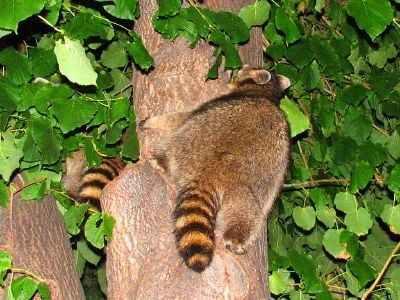
The original habitats of the common raccoon are deciduous and mixed forests of North America, but due to their adaptability they have extended their range to mountainous areas, coastal marshes, and urban areas, where many homeowners consider them to be pests.
Although they have thrived in sparsely wooded areas in the last decades, raccoons depend on vertical structures to climb when they feel threatened. Therefore, they avoid open terrain and areas with high concentrations of beech trees, as beech bark is too smooth to climb. Tree hollows in old oaks or other trees and rock crevices are preferred by raccoons as sleeping, winter, and litter dens. If such dens are unavailable or accessing them is inconvenient, raccoons use burrows dug by other mammals, dense undergrowth, roadside culverts in urban areas, or tree crotches. In a study in the Solling range of hills in Germany, more than 60% of all sleeping places were used only once, but those used at least ten times accounted for about 70% of all uses. Since amphibians, crustaceans, and other animals found around the shore of lakes and rivers are an important part of the raccoon's diet, lowland deciduous or mixed forests abundant with water and marshes sustain the highest population densities. While population densities range from 0.5 to 3.2 animals per square kilometre (0.2 – 1.2 animals per square mile) in prairies and do not usually exceed 6 animals per square kilometer (2.3 animals per square mile) in upland hardwood forests, more than 20 raccoons per square kilometer (50 animals per square mile) can live in lowland forests and marshes.[6][5]
Diet
The common raccoon's diet consists of about 40 percent invertebrates, 33 percent plant material, and 27 percent vertebrates.[6] Since its diet consists of such a variety of different foods, Zeveloff argues the raccoon "may well be one of the world's most omnivorous animals".[5] While its diet in spring and early summer consists mostly of insects, worms, and other animals already available early in the year, it prefers fruits and nuts, such as acorns and walnuts, which emerge in late summer and autumn, and represent a rich calorie source for building up fat needed for winter.[6][7] They only occasionally eat active or large prey, such as birds and mammals, preferring prey that is easier to catch, specifically fish and amphibians.[6] Bird nests (eggs and after hatchlings) are frequently preyed on, and small birds are often helpless to prevent the attacking raccoon. When food is plentiful, raccoons can develop strong individual preferences for specific foods.[7]
Predators and life expectancy
The most important natural predators of the common raccoon are bobcats, coyotes, and great horned owls, the latter mainly preying on young raccoons. Bald eagles are another bird that preys on raccoons. In their introduced range in the former Soviet Union, their main predators are wolves, lynxes, and eagle owls.[24] However, predation is not a significant cause of death, especially because larger predators have been exterminated in many areas inhabited by raccoons.[5]
Primary causes of raccoon mortality include humans (hunting, trapping, cars), malnutrition, and disease.[30] Young raccoons are vulnerable to losing their mother and to starvation, particularly in long and cold winters.[7] The most frequent natural cause of death in the North American raccoon population is distemper, which can reach epidemic proportions and kill most of a local raccoon population. In areas with heavy vehicular traffic and extensive hunting, these factors can account for up to 90 percent of all deaths of adult raccoons.[6]
Raccoons can live up to 16 years in the wild, though most do not make it through their second year. A raccoon that survives past its youth will live an average of five years. Captive raccoons have been known to live for more than 20 years.[25] However, the species' life expectancy in the wild is only 1.8 to 3.1 years, depending on the local conditions in terms of traffic volume, hunting, and weather severity.[5] It is not unusual for only half of the young born in one year to survive a full year; after this point, the annual mortality rate drops to between 10% and 30%.[6]
Range of the common raccoon
Distribution in North America
Raccoons are common throughout North America from Canada through Mexico, and continuing into Panama in Central America, where the subspecies P. l. pumilus coexists with the crab-eating raccoon (P. cancrivorus). The population on Hispaniola was exterminated as early as 1513 by Spanish colonists who hunted them for their meat.[4] Raccoons were also exterminated in Cuba and Jamaica, where the last sightings were reported in 1687.[4] The Bahaman raccoon (P. l. maynardi) was classified as endangered by the IUCN in 1996.[5]
There is evidence that in pre-Columbian times raccoons were numerous only along rivers and in the woodlands of the Southeastern United States. As raccoons were not mentioned in earlier reports of pioneers exploring the central and north-central parts of the United States, their initial spread may have begun a few decades before the 20th century. Since the 1950s, raccoons have expanded their range from Vancouver Island—formerly the northernmost limit of their range—far into the northern portions of the four south-central Canadian provinces. New habitats that have recently been occupied by raccoons (aside from urban areas) include mountain ranges, such as the Western Rocky Mountains, prairies, and coastal marshes. After a population explosion starting in the 1940s, the estimated number of raccoons in North America in the late 1980s was 15 to 20 times higher than in the 1930s, when raccoons were comparatively rare. Urbanization, the expansion of agriculture, deliberate introductions, and the extermination of natural predators of the raccoon have probably caused this increase in abundance and distribution.[5]
Distribution outside North America
As a result of escapes and deliberate introductions in the mid-20th century, the raccoon is now distributed in several European and Asian countries. Sightings have occurred in all the countries bordering Germany, which hosts the largest population outside of North America.[23] The estimated number of raccoons was 285 animals in the Hessian region in 1956, over 20,000 animals in the Hessian region in 1970 and between 200,000 and 400,000 animals in the whole of Germany in 2008.[6] Another stable population exists in northern France, where several pet raccoons were released by members of the U.S. Air Force near the Laon-Couvron Air Base in 1966.[6] About 1,240 animals were released in nine regions of the former Soviet Union between 1936 and 1958 for the purpose of establishing a population to be hunted for their fur. Two of these introductions were successful: one in the south of Belarus between 1954 and 1958, and another in Azerbaijan between 1941 and 1957. With a seasonal harvest of between 1,000 and 1,500 animals, in 1974 the estimated size of the population distributed in the Caucasus region was around 20,000 animals and the density was four animals per square kilometer (10 animals per square mile).[23]
In Japan, up to 1,500 raccoons were imported as pets each year after the success of the anime series Rascal the Raccoon (1977). In 2004, the descendants of discarded or escaped animals lived in 42 of 47 prefectures.[31]
Urban raccoons
Due to its adaptability, the raccoon has been able to use urban areas as a habitat. The first sightings were recorded in a suburb of Cincinnati in the 1920s. Since the 1950s, raccoons have been present in Washington, D.C., Chicago, and Toronto.[32] Since the 1960s, Kassel has hosted Europe's first and densest population in a large urban area, with about 50 to 150 animals per square kilometer (130–400 animals per square mile), a figure comparable to those of urban habitats in North America.[32][6] Home range sizes of urban raccoons are only three to 40 hectares (7.5–100 acres) for females and eight to 80 hectares (20–200 acres) for males. In small towns and suburbs, many raccoons sleep in a nearby forest after foraging in the settlement area.[32][25] Fruit and insects in gardens and leftovers in municipal waste are easily available food sources. Furthermore, a large number of additional sleeping areas exist in these areas, such as hollows in old garden trees, cottages, garages, abandoned houses, and attics. The percentage of urban raccoons sleeping in abandoned or occupied houses varies from 15% in Washington, D.C. (1991) to 43% in Kassel (2003).[25][6]
Health
Raccoons can carry rabies, a lethal disease caused by the neurotropic rabies virus carried in the saliva and transmitted by bites. The U.S. Department of Agriculture, as well as local authorities in several U.S. states and Canadian provinces, has developed oral vaccination programs to fight the spread of the disease in wildlife rabies and thus likewise protect people, livestock, and pets from this disease.[33]
Among the main symptoms for rabies in raccoons are a generally sickly appearance, impaired mobility, abnormal vocalization, and aggressiveness.[34] There may be no visible signs at all, however, and most individuals do not show the aggressive behavior seen in infected canids; rabid raccoons will often retire to their dens instead.[34] Organizations like the U.S. Forest Service encourage people to stay away from animals with unusual behavior or appearance, and to notify the proper authorities, such as an animal control officer from the local health department.[35] Since healthy animals, especially nursing mothers, will occasionally forage during the day, daylight activity is not a reliable indicator of illness in raccoons.[25]
Unlike rabies and at least a dozen other pathogens carried by raccoons, distemper, an epizootic virus, does not affect humans.[7] This disease is the most frequent natural cause of death in the North American raccoon population and affects individuals of all age groups. For example, 94 of 145 raccoons died during an outbreak in Clifton, Ohio, in 1968. It may occur along with a following inflammation of the brain (encephalitis), causing the animal to display rabies-like symptoms.[5]
Some of the most important bacterial diseases that affect raccoons are leptospirosis, listeriosis, tetanus, and tularemia. Although internal parasites weaken their immune systems, well-fed individuals can carry a great many roundworms in their digestive tracts without showing symptoms.[7] The larvae of the Baylisascaris procyonis roundworm, which can be contained in the feces and seldom causes a severe illness in humans, can be ingested when cleaning raccoon latrines without wearing breathing protection.[6]
Raccoons and people
Conflicts with people and pets
The increasing number of raccoons in urban areas has resulted in diverse reactions in humans, ranging from outrage at their presence to deliberate feeding. Some wildlife experts and most public authorities caution against feeding wild animals because they might become increasingly obtrusive and dependent on humans as a food source.[25] Other experts challenge such arguments and even may give advice on feeding raccoons and other wildlife.[4][36] Raccoons without fear of humans are a concern to those who attribute this trait to rabies, but scientists point out this behavior is much more likely to be a behavioral adjustment to living in habitats with regular contact to humans for many generations.[25] Serious attacks on humans by groups of nonrabid raccoons are extremely rare and are almost always the result of the raccoon feeling threatened; at least one such attack has been documented.[37] Raccoons usually do not prey on domestic cats and dogs, but individual cases of killings have been reported.[38]
While overturned waste containers and raided fruit trees are just a nuisance to homeowners, it can cost several thousand dollars to repair damage caused by the use of attic space as dens.[32] Relocating or killing raccoons without a permit is forbidden in many urban areas on grounds of animal welfare. These methods usually only solve problems with particularly wild or aggressive individuals, since adequate dens are either known to several raccoons or will quickly be rediscovered.[35] Loud noises, flashing lights and unpleasant odors have proven particularly effective in driving away a mother and her kits before they would normally leave the nesting place (when the kits are about eight weeks old).[35] Typically, though, only precautionary measures to restrict access to food waste and denning sites are effective in the long term.[35][25][6]
Among all fruits and crops cultivated in agricultural areas, sweet corn in its milk stage is particularly popular among raccoons.[6][7] Like other predators, raccoons searching for food can break into poultry houses to feed on chickens, ducks, their eggs, or feed.[35][7] Since they may enter tents and try to open locked containers on camping grounds, campers are advised to not keep food or toothpaste inside a tent.
Hunting and fur trade
The fur of raccoons is used for clothing, especially for coats and coonskin caps. It also has been the material used for the inaccurately named "sealskin" cap worn by the Royal Fusiliers of Great Britain.[39] Historically, Native American tribes not only used the fur for winter clothing, but also used the tails for ornament.[4]
In the 19th century, when coonskins occasionally even served as means of payment, several thousand raccoons were killed each year in the United States.[4][5] This number rose quickly when automobile coats became popular after the turn of the 20th century. In the 1920s, wearing a raccoon coat was regarded as status symbol among college students.[4] Attempts to breed raccoons in fur farms in the 1920s and 1930s in North America and Europe turned out not to be profitable, and farming was abandoned after prices for long-haired pelts dropped in the 1940s.[5][40]
Although raccoons had become rare in the 1930s, at least 388,000 were killed during the hunting season of 1934/35. After persistent population increases began in the 1940s, the seasonal hunt reached about one million animals in 1946/47 and two million in 1962/63.[4][5]
In the late 1940s and early 1950s, there was a spike in demand for coonskin caps in the United States. Major factors included the 1948 senatorial campaign of Estes Kefauver, who wore such a cap for promotional purposes,[41] and the broadcast in 1954 and 1955 of three television episodes and a film (Davy Crockett, King of the Wild Frontier) about the frontiersman Davy Crockett (though the caps supplied to the fad were typically made of faux fur with a raccoon tail attached). Ironically, it is unlikely either Crockett or the actor who played him, Fess Parker, actually wore a cap made from raccoon fur.[5]
The seasonal hunt reached an all-time high with 5.2 million animals in 1976/77 and ranged between 3.2 and 4.7 million for most of the 1980s. In 1982, the average pelt price was $20.[19] In the first half of the 1990s, the seasonal hunt dropped to 0.9 to 1.9 million due to decreasing pelt prices.[5]
As of 1987, the raccoon was identified as the most important wild furbearer in North America in terms of revenue.[19]
In many parts of the United States, raccoon hunting is done at night with dogs, usually breeds of "coonhounds." Since the late 18th century, various types of scent hounds (coonhounds), which are able to tree animals, have been bred in the United States.[42] The dogs track the raccoon until it seeks refuge, usually in a tree, where it is either harvested or left for future hunts. Hunters can tell the progress of tracking by the type of bark emitted by the dogs; a unique bark indicates the raccoon has been "treed."
As food
While primarily hunted for their fur, common raccoons were also a source of food for Native Americans and have been a traditional food for Americans from early days. While raccoon was eaten by American slaves at Christmas,[43] it was not necessarily a dish of the poor or rural; in the December 21, 1856 edition of San Francisco's newspaper The Golden Era, raccoon is among the specialties advertised for the holiday, and US President Calvin Coolidge's pet raccoon Rebecca was originally sent to be served at the White House Thanksgiving Dinner.[44][45] The first edition of the cookbook The Joy of Cooking, released in 1931, contained a recipe for preparing raccoon.[46]
Because raccoons are generally thought of as endearing, cute, and/or varmints, the idea of eating them is typically repulsive to mainstream consumers in the United States.[47][46] However, many thousands of raccoons are still eaten each year in the United States. Although the Delafield (Wisconsin) Coon Feed has been an annual event since 1928, the common raccoon's culinary use is mainly identified with certain regions of the American South like Arkansas where the Gillett Coon Supper is an important political event.[48][49]
As pets
Raccoons are sometimes raised as pets, although they may act unpredictably and aggressively and it can be quite difficult to teach them to obey and understand commands.[25] Some states in the United States do not allow keeping wild animals as pets, and some states require an exotic pet permit.[7]
Sexually mature raccoons often show aggressive natural behaviors such as biting during the mating season. Neutering them at around five or six months of age decreases the chances of aggressive behavior developing. Raccoons can become obese and suffer from other disorders due to poor diet and lack of exercise. When fed with cat food over a long time period, raccoons can develop gout.[6]
Raccoons are usually kept in a pen (indoor or outdoor)—also a legal requirement in Austria and Germany—rather than in the home where their natural curiosity may result in damage to property.[25] When orphaned, it is possible for kits to be rehabilitated and reintroduced to the wild. However, it is uncertain whether they readapt well to life in the wild.[7]
Mythology, arts, and entertainment
In the mythology of the indigenous peoples of the Americas, the raccoon was the subject of folk tales. Native American stories such as "How raccoons catch so many crayfish" from the Tuscarora tribe centered on its skills at foraging. In other tales, the raccoon played the role of the trickster that outsmarts other animals, like coyotes and wolves. Among others, the Dakota Sioux believed the raccoon had natural spirit powers, since its mask resembled the facial paintings, two-fingered swashes of black and white, used during rituals to connect to spirit beings. The Aztecs linked supernatural abilities especially to females, whose commitment to their young was associated with the role of wise women in the tribal society.[4]
The raccoon also appears in Native American art across a wide geographic range. Petroglyphs with engraved raccoon tracks were found in Lewis Canyon, Texas; at the Crow Hollow petroglyph site in Grayson County, Kentucky;[50] and in river drainages near Tularosa, New Mexico and San Francisco, California.[51] A true-to-detail figurine made of quartz, the Ohio Mound Builders' Stone Pipe, was found near the Scioto River. The meaning and significance of the Raccoon Priests Gorget, which features a stylized carving of a raccoon and was found at Spiro Mounds, Oklahoma, remains unknown.[52]
In Western culture, several autobiographical novels about living with a raccoon have been written, mostly for children. The best-known is Sterling North's Rascal, which recounts how he raised a kit during World War I.
Notes
- ↑ 1.0 1.1 1.2 W. Wozencraft, and W. Christopher, "Procyon," in D. E. Wilson and D. M. Reeder (eds.), Mammal Species of the World: A Taxonomic and Geographic Reference (3rd ed.) (Baltimore: Johns Hopkins University Press, 2005, ISBN 9780801882210).
- ↑ 2.0 2.1 2.2 K. M. Helgen, and D. E. Wilson, "Taxonomic status and conservation relevance of the raccoons (Procyon spp.) of the West Indies," Journal of Zoology 259(2003): 69–76. Retrieved October 25, 2023.
- ↑ 3.0 3.1 K.-P. Koepfli, M. E. Gompper, E. Eizirik, C.-C. Ho, L. Linden, J. E. Maldonado, and R. K. Wayne, "Phylogeny of the Procyonidae (Mammalia: Carnivora): Molecules, morphology and the Great American Interchange," Molecular Phylogenetics and Evolution 43(2007): 1076–1095. Retrieved October 25, 2023.
- ↑ 4.00 4.01 4.02 4.03 4.04 4.05 4.06 4.07 4.08 4.09 4.10 4.11 4.12 4.13 4.14 4.15 V. C. Holmgren, Raccoons in Folklore, History and Today's Backyards (Santa Barbara, CA: Capra Press, 1990, ISBN 978-0884963127).
- ↑ 5.00 5.01 5.02 5.03 5.04 5.05 5.06 5.07 5.08 5.09 5.10 5.11 5.12 5.13 5.14 5.15 5.16 5.17 5.18 5.19 5.20 5.21 5.22 5.23 5.24 5.25 5.26 5.27 5.28 5.29 5.30 5.31 5.32 5.33 5.34 5.35 5.36 5.37 5.38 5.39 5.40 5.41 5.42 5.43 5.44 5.45 5.46 5.47 5.48 5.49 5.50 S. I. Zeveloff, Raccoons: A Natural History (Washington, DC: Smithsonian Books, 2002, ISBN 9781588340337).
- ↑ 6.00 6.01 6.02 6.03 6.04 6.05 6.06 6.07 6.08 6.09 6.10 6.11 6.12 6.13 6.14 6.15 6.16 6.17 6.18 6.19 6.20 6.21 6.22 6.23 6.24 6.25 6.26 6.27 6.28 6.29 6.30 6.31 6.32 6.33 6.34 6.35 6.36 6.37 6.38 6.39 6.40 U. Hohmann, I. Bartussek, and B. Böer, Der Waschbär (Reutlingen, Germany: Oertel+Spörer, 2001, ISBN 9783886273010).
- ↑ 7.00 7.01 7.02 7.03 7.04 7.05 7.06 7.07 7.08 7.09 7.10 7.11 7.12 7.13 7.14 7.15 7.16 7.17 7.18 7.19 7.20 7.21 7.22 7.23 7.24 7.25 7.26 7.27 7.28 7.29 7.30 D. MacClintock, A Natural History of Raccoons (Caldwell, NJ: The Blackburn Press, 1981, ISBN 9781930665675).
- ↑ 8.0 8.1 F. Reid and K. Helgen, and J. F. González-Maya, "Procyon cancrivorus," 2016 IUCN Red List of Threatened Species. Retrieved October 25, 2023.
- ↑ 9.0 9.1 9.2 9.3 9.4 9.5 N. Phillips, and L. Olson, "Procyon cancrivorus," Animal Diversity Web. Retrieved October 25, 2023.
- ↑ 10.0 10.1 10.2 10.3 A. D. Cuarón, P. D. de Grammont, E. Vázquez-Domínguez, D. Valenzuela-Galván, D. García-Vasco, F. Reid, and K. Helgen, "Procyon pygmaeus," 2016 IUCN Red List of Threatened Species. Retrieved October 25, 2023.
- ↑ 11.0 11.1 11.2 K. M. Helgen, and D. E. Wilson, "A systematic and zoogeographic overview of the raccoons of Mexico and Central America," in V. Sanchez-Cordero, and R. A. Medellin (eds.), Contribuciones Mastozoologicas: En Homenaje a Bernardo Villa (Mexico City: Instituto de Biologia e Instituto de Ecologia, UNAM, 2005, ISBN 978-9703226030), 219–234.
- ↑ 12.0 12.1 12.2 12.3 K. W. McFadden, R. N. Sambrotto, R. A. Medellín, and M. E. Gompper, "Feeding habits of endangered pygmy raccoons (Procyon pygmaeus) based on stable isotope and fecal analyses," J Mammal 87(2006): 501–509.
- ↑ C. H. Merriam, "Six new mammals from Cozumel Island, Yucatan," Proceedings of the Biological Society of Washington 14(1901): 99–104.
- ↑ 14.0 14.1 14.2 A. D. Cuaron, M. A. Martinez-Morales, K. W. McFadden, D. Valenzuela, and M. E. Gompper, "The status of dwarf carnivores on Cozumel Island, Mexico," Biodivers Conserv 13(2004): 317–331.
- ↑ E. A. Goldman, H. H. T. Jackson, "Raccoons of North and Middle America," North American Fauna 60(1950): 1–153.
- ↑ N. L. Hamblin, Animal Use by the Cozumel Maya (Tucson: The University of Arizona Press, 1984, ISBN 0816508240).
- ↑ 17.0 17.1 K. W. McFadden, D. García-Vasco, A. D. Cuarón, D. Valenzuela-Galván, R. A. Medellín, and M. E. Gompper, "Vulnerable island carnivores: The endangered endemic dwarf procyonids from Cozumel Island," Biodiversity Conservation 19(2) (2010):491-502.
- ↑ J. A. Alcover, and M. McMinn, "Predators of vertebrates on islands," Bioscience 44(1994): 12–18.
- ↑ 19.0 19.1 19.2 19.3 A. R. Glatston (ed.), The Red Panda, Olingos, Coatis, Raccoons, and Their Relatives: Status Survey and Conservation Action Plan for Procyonids and Ailurids (IUCN/SSC Mustelid, Viverrid & Procyonid Specialist Group Edition, 1994, ISBN 2831700469.
- ↑ 20.0 20.1 20.2 K. W. McFadden, S. E. Wade, E. J. Dubovi, and M. E. Gompper, "A serology and fecal parsitology survey of the critically endangered pygmy raccoon (Procyon pygmaeus)," J Wildlife Diseases 41(2005): 615–617.
- ↑ R. Timm, A. D. Cuarón, F. Reid, and K. Helgen, "Procyon lotor," IUCN Red List of Threatened Species 2016. Retrieved October 26, 2023.
- ↑ S. Larivière, "Range expansion of raccoons in the Canadian prairies: Review of hypotheses," Wildlife Society Bulletin 32(3) (2004): 955–963.
- ↑ 23.00 23.01 23.02 23.03 23.04 23.05 23.06 23.07 23.08 23.09 23.10 23.11 A. Lagoni-Hansen, Der Waschbär (Mainz, Germany: Verlag Dieter Hoffmann, 1981, ISBN 3873410370).
- ↑ 24.0 24.1 V. G. Heptner and A. A. Sludskii, Mammals of the Soviet Union, Vol. II, part 1b, Carnivores(Mustelidae & Procyonidae) (Washington, DC: Smithsonian Institution Libraries and National Science Foundation, 2002, ISBN 9004088768).
- ↑ 25.00 25.01 25.02 25.03 25.04 25.05 25.06 25.07 25.08 25.09 25.10 25.11 25.12 I. Bartussek, Die Waschbären kommen (Niedenstein, Germany: Cognitio, 2004, ISBN 9783932583100).
- ↑ A. D. Saunders, "Raccoon (Procyon lotor)" in A. D. Saunders, Adirondack Mammals (Syracuse, NY: Syracuse University Press, 1989, ISBN 9780815681151).
- ↑ H. B. Davis, "The raccoon: A study in animal intelligence," American Journal of Psychology 18(4) (1907): 447–489.
- ↑ S. Dehaene, The Number Sense (New York: Oxford University, 1997, ISBN 0195110048).
- ↑ S. Gehrt and E. K. Fritzell, "Behavioural aspects of the raccoon mating system: Determinants of consortship success," Animal Behaviour 57(3) (1999): 593–601.
- ↑ T. Dewey and R. Fox, "Procyon lotor: Northern raccoon," Animal Diversity Web. Retrieved October 26, 2023.
- ↑ T. Ikeda, M. Asano, Y. Matoba, and G. Abe, "Present status of invasive alien raccoon and its impact in Japan," Global Environmental Research 8(2) (2004): 125–131.
- ↑ 32.0 32.1 32.2 32.3 F.-U. Michler, Untersuchungen zur Raumnutzung des Waschbären (Procyon lotor, L. 1758) im Urbanen Lebensraum am Beispiel der Stadt Kassel (Nordhessen) (University of Halle-Wittenberg: Diploma Thesis, 2003). Retrieved October 26, 2023.
- ↑ U.S. Department of Agriculture, "Oral Rabies Vaccination" Animal and Plant Health Inspection Service, United States Department of Agriculture (July 27, 2020 ). Retrieved October 26, 2023.
- ↑ 34.0 34.1 R. Rosatte, K. Sobey, D. Donovan, et al., "Behavior, movements, and demographics of rabid raccoons in Ontario, Canada: Management implications," Journal of Wildlife Diseases 42(3) (2006):589–605.
- ↑ 35.0 35.1 35.2 35.3 35.4 "Raccoons (Procyon lotor)," Washington Department of Fish and Wildlife. Retrieved October 26, 2023.
- ↑ S. Harris and P. Baker, Urban Foxes (Suffolk: Whittet Books, 2001, ISBN 9781873580516).
- ↑ Associated Press, "Raccoons maul Fla. woman, 74, who shooed them away," Seattle Times (October 6, 2009). Retrieved October 26, 2023.
- ↑ Associated Press, Raccoons rampaging Olympia: Animals have killed 10 cats, bitten one person," Seattle Post-Intelligencer (August 23, 2006). Retrieved October 26, 2023.
- ↑ W. Y. Carman, A Dictionary of Military Uniform (New York: Scribner, 1977, ISBN 0684151308).
- ↑ F. Schmidt, Das Buch von den Pelztieren und Pelzen (Munich: F. C. Mayer Verlag, 1970).
- ↑ C. L. Fontenay, Estes Kefauver: A Biography (Knoxville, TN: Olympic Marketing Corp, 1980, ISBN 0870492624).
- ↑ American Kennel Club, "Black and tan coonhound history," American Kennel Club. Retrieved October 26, 2023.
- ↑ H. Jacobs, Incidents in the Life of a Slave Girl: Written by Herself (New York: Barnes & Noble Classics, 2005, ISBN 1593082835).
- ↑ H. Lockwood, San Diego's Hysterical History (Raton, N.M.: Coda, 2003, ISBN 0910390673).
- ↑ J. O'Neill, "White House life: Filling the position of first pet," Finding Dulcinea (May 12, 2010). Retrieved October 26, 2023.
- ↑ 46.0 46.1 Lee Hill Kavanaugh, "The other dark meat: Raccoon is making it to the table," Ledger-Enquirer (January 14, 2009). Retrieved October 26, 2023.
- ↑ M. Twohey, "Raccoon dinner: Who's game? Illinois, it turns out, has bountiful supply of the critters—and fans and foodies are gobbling them up," Chicago Tribune January 18, 2008.
- ↑ M. Berry and American Folklife Center, "Gillett coon supper," The Library of Congress: Local Legacies. Retrieved October 26, 2023.
- ↑ E. Bultman, "Coon feed still packs ‘em in," gmtoday (January 28, 2008). Retrieved October 26, 2023.
- ↑ F. E. Coy, T. C. Fuller, L. G. Meadows, and J. L. Swauger, Rock Art of Kentucky (Lexington, KY: University Press of Kentucky, 2004, ISBN 0813190851).
- ↑ P. Schaafsma, Indian Rock Art of the Southwest (Santa Fe, NM: School of American Research, 1992, ISBN 0826309135).
- ↑ E. L. Wade, The Arts of the North American Indian: Native Traditions in Evolution (Hudson Hills, 1986, ISBN 0933920563).
ReferencesISBN links support NWE through referral fees
- Bartussek, I. Die Waschbären kommen. Niedenstein, Germany: Cognitio, 2004. ISBN 978-3932583100
- Carman, W. Y. A Dictionary of Military Uniform. New York: Scribner, 1977. ISBN 0684151308
- Coy, F. E., T. C. Fuller, L. G. Meadows, and J. L. Swauger. Rock Art of Kentucky. Lexington, KY: University Press of Kentucky, 2004. ISBN 0813190851
- Dehaene, S. The Number Sense. New York: Oxford University, 1997. ISBN 0195110048
- Fontenay, C. L. Estes Kefauver: A Biography. Knoxville, TN: Olympic Marketing Corp, 1980. ISBN 0870492624
- Glatston, A. R. The Red Panda, Olingos, Coatis, Raccoons, and Their Relatives: Status Survey and Conservation Action Plan for Procyonids and Ailurids. IUCN/SSC Mustelid, Viverrid & Procyonid Specialist Group Edition: 1994. ISBN 2831700469
- Hamblin, N. L. Animal Use by the Cozumel Maya. Tucson, AZ: The University of Arizona Press, 1984. ISBN 0816508240
- Harris, S., and P. Baker. Urban Foxes. Suffolk: Whittet Books, 2001. ISBN 9781873580516
- Heptner, V. G., and A. A. Sludskii. Mammals of the Soviet Union, Vol. II, part 1b, Carnivores (Mustelidae & Procyonidae). Washington, DC: Smithsonian Institution Libraries and National Science Foundation, 2002. ISBN 9004088768
- Hohmann, U., I. Bartussek, and B. Böer. Der Waschbär. Reutlingen, Germany: Oertel+Spörer, 2001. ISBN 978-3886273010
- Holmgren, V. C. Raccoons in Folklore, History and Today's Backyards. Santa Barbara, CA: Capra Press, 1990. ISBN 978-0884963127
- Jacobs, H. Incidents in the Life of a Slave Girl: Written by Herself. New York: Barnes & Noble Classics, 2005. ISBN 1593082835
- Lagoni-Hansen, A. Der Waschbär. Mainz, Germany: Verlag Dieter Hoffmann, 1981. ISBN 3873410370
- Lockwood, H. San Diego's Hysterical History. Raton, NM: Coda, 2003. ISBN 0910390673
- MacClintock, D. A Natural History of Raccoons. Caldwell, NJ: The Blackburn Press, 1981. ISBN 978-1930665675
- Sanchez-Cordero, V., and R. A. Medellin (eds.). Contribuciones Mastozoologicas: En Homenaje a Bernardo Villa. Mexico City: Instituto de Biologia e Instituto de Ecologia, UNAM, 2005. ISBN 978-9703226030
- Saunders, A. D. Adirondack Mammals. Syracuse, NY: Syracuse University Press, 1989. ISBN 978-0815681151
- Schaafsma, P. Indian Rock Art of the Southwest. Santa Fe, NM: School of American Research, 1992. ISBN 0826309135
- Schmidt, F. Das Buch von den Pelztieren und Pelzen. Munich: F. C. Mayer Verlag, 1970.
- Wade, E. L. The Arts of the North American Indian: Native Traditions in Evolution. Hudson Hills, 1986. ISBN 0933920563
- Wilson, D. E., and D. M. Reeder (eds.). Mammal Species of the World: A Taxonomic and Geographic Reference. (3rd ed.) Baltimore, MD: Johns Hopkins University Press, 2005. ISBN 978-0801882210
- Zeveloff, S. I. Raccoons: A Natural History. Washington, DC: Smithsonian Books, 2002. ISBN 978-1588340337
| ||||||||
Credits
New World Encyclopedia writers and editors rewrote and completed the Wikipedia article in accordance with New World Encyclopedia standards. This article abides by terms of the Creative Commons CC-by-sa 3.0 License (CC-by-sa), which may be used and disseminated with proper attribution. Credit is due under the terms of this license that can reference both the New World Encyclopedia contributors and the selfless volunteer contributors of the Wikimedia Foundation. To cite this article click here for a list of acceptable citing formats.The history of earlier contributions by wikipedians is accessible to researchers here:
The history of this article since it was imported to New World Encyclopedia:
Note: Some restrictions may apply to use of individual images which are separately licensed.
